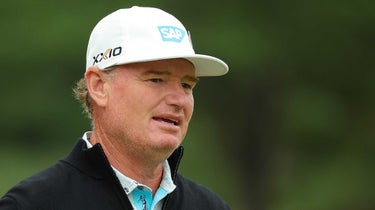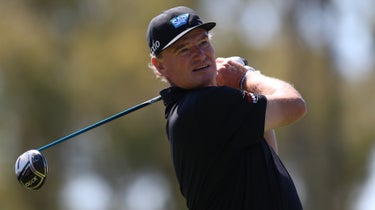
Ernie Els hits his tee shot on Saturday on the 1st hole at Norwood Hills Country Club.
Getty Images
The Big Easy is worried about those who swing hard.
On one of modern golf’s more discussed subjects, Ernie Els had some thoughts.
“The body’s not built,” he said, “for hitting a driver at 130 miles per hour.”
Els was talking ahead of this week’s Ascension Charity Classic on the PGA Tour Champions circuit, and while not a doctor, you could safely call him a swing expert. There’s the resume — he won 19 times on the PGA Tour, including four majors, and 42 times internationally. There’s the nickname, too. Els isn’t called what he’s called for being laborious with his move to the ball.
But here’s his take on the Big Easy nickname:
“If you look at my swing, it looks like it’s kind of slow-motion kind of thing,” he said a few years back. “Although I don’t feel it at times — I feel like I’m swinging too fast sometimes. But because of my frame, my swing looks wide and kind of slow. And hence the word Big Easy — a big swing and easy rhythm. It stuck.”
So no, it was not surprising that Els has at least a thought about swing speed, though the topic is front of mind. In short, the harder you swing, the farther the ball goes, and shots that follow become closer — and players have bought in. In a look at the PGA Tour’s stats for club head speed, pros averaged 115.20 mph this year, which is short of what Els noted, but is up 3 mph since 2007, when the metric started to be recorded. Notably, ball speed numbers are also up over that time period — this year, pros averaged 173.01 mph, up 8 mph since 2007.
And that led to this exchange at the Ascension, which was started by a reporter:
“When you were a young man on tour, still developing your game, break it down on the course, on the range, short game, how would those percentages have broken down? And how much has that changed now that technology has become a big part of that process?”
“Good question,” Els began. “I mean, I felt like I was a bit of a range rat away from tournaments. At tournament sites, I didn’t really get all those hours on the range. I basically did all my work before I got to tournaments, especially with David Ledbetter, especially when we lived in Orlando, and David being in Orlando. I was out there. If I had a week off, I would be there five days out of the weekdays. A lot of work there on the range.
“My short game was always pretty sharp. I think I was just gifted with that kind of ability. But I did spend a lot of time on the short game. Putting was always kind of there.
“Now it’s kind of flipped around a bit. I spend a lot more time around the greens and on the greens, a little bit less time on the range just because of the body. Body’s a little different now.”
“What about the technology?”
“Technology, very different now,” Els said. “In those days, we didn’t get all the help from technology, and the game was different. Didn’t have to go after the ball as hard. Now it seems like everybody is going after it 100 percent. I always felt like I played 85 percent just to keep the ball in play long enough to be able to do that.
“Now things have changed. You have to go 110 percent on the driver. I think the body will break down even quicker now, even with how strong the guys are. The body’s not built for hitting a driver at 130 miles per hour.”
It’s here where we’ll again note that Els is no doctor. And that actual ones have protocols in place to safely build up speed. And players adding speed is almost universal now.
But like anything physical, there are limits.
So Els is worried.
But perhaps there’s a fix. At least says Bryson DeChambeau, who has bought in significantly to speed.
We’ll end things here with this exchange he had last year with teacher and analyst Mark Immelman, on Immelman’s On the Mark podcast.
In it DeChambeau said his work with Kyle Berkshire and others of Long Drive fame revealed that “it’s not about how fast you swing the golf club” to create more speed.
“So like during the November Masters, I was just swinging as fast as I could. Back and forth, quick as I can,” DeChambeau said. “So from the time to start to impact was super fast. Doesn’t mean I’m going to swing fast. … In order to create the most velocity at a certain point in time, you have to have time to accelerate. And distance.”
“Like Talladega versus Bristol Speedways,” Immelman said, referring to the longest NASCAR track, and one of the shortest.
“You have to have time — you can have a huge engine and get there really quickly, but that’s under a shorter amount of distance, right,” DeChambeau said. “Or you can get there by a super long swing applying the same acceleration to it. So you want something that has the same acceleration to it for a longer duration that allows you to get higher velocity.
“That’s why when people swing it slower and softer, they go faster. Because their stretch-shortening cycle of their muscles, lot more efficient, because there’s no tension. The tension is what absolutely ruins the stretch-shortening cycle. It’s like a rubber band, pulling it back and letting it go. When people swing smooth and take it a little longer back and take more time at the top, that gives them the ability to accelerate the club through the stretch-shortening cycle a lot more efficiently and they can hit it farther.
“So what I was doing was just try to swing as fast as possible to get it to go as far. Well, that caused a concussion. It’s obviously not the right route to go. So don’t try and swing fast when you’re hitting it hard. In order to hit it farther, in order to have a faster ball speed, a faster clubhead speed, at the right moment in time, that is the key. You don’t need to accelerate the club really fast. You need to have the speed down right through impact. So in order to produce more speed through the ball, you have to take a longer, softer, wider swing. And if you can do that, and load the wrists, and then unload it, and stay tall through impact — don’t shrink down, because that increases the lever length and you can rip the club a lot faster — you’ll produce more speed in the golf swing. And that’s what I started to realize after watching Kyle.
“We did a synchronization of our two golf swings. His golf swing took like .2 seconds longer almost. .2 seconds longer. I had a faster swing, and he was 20 mph faster. At that time, I was swinging 135, and he was close to 155.”













